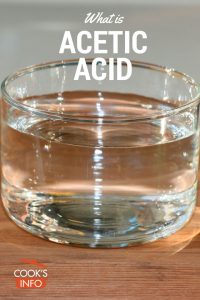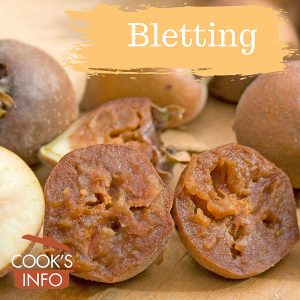Acetic acid (aka ethanoic acid) is an odourless, colourless carboxylic acid. Pure acetic acid is clear with no colour. The smell is very irritating to the nose. The liquid is extremely corrosive to skin and it is not safe to consume. Acetic acid is very sour in taste even in diluted quantities. Acetic acid production Acetic…
Technical Terms
Adobado
“Adobado” is the adjective in Spanish used to describe dishes marinated or cooked in Adobo sauce. Examples of dishes included lomo adobado (marinated pork loin), chamorro adobado (marinated pork shank), conejo adobado (marinated rabbit), pollo adobado (marinated chicken), etc. Language Notes On rare occasions, mis-spelt by English speakers as “Adabado.”
Air-Layered
Air-Layering is the art of getting a new plant to sprout from the branch of an existing one, while the branch is still attached to the existing tree. Since branches are usually in the air, the technique is called “Air” Layering. The resulting plant will be a cultivar, the same as the parent one, so…
Alliumophobia
Alliumophobia is a coined term meaning “fear of garlic.” And, as every comedian in the kitchen will add, “vampires suffer from this.”
Alpha Amylase
Alpha Amylase is an enzyme present naturally in many things from egg yolk to wheat kernels to the saliva in your mouth [1]. It breaks long starch molecules into sugars (small dextrins, glucose and maltose) that can be absorbed easily into the body, or eaten by yeast. This break-down process is called “hydrolysis.” It is…
Alum
Alum is a short-form word for an ingredient otherwise known as “potassium aluminum sulfate.” Sold in crystals, there are both food and commercial grades; the food grade is available at some pharmacies. Alum was called for in older pickling recipes to give pickles a good, crisp crunch and helped ensure that they didn’t just come…
Alveograph
An Alveograph (aka “Chopin Alveograph”) is a tool used to help determine what a particular wheat flour is useful for. The Alveograph uses air pressure to inflate a thin sheet of dough, simulating the carbon dioxide bubbles that are present in bread dough, that cause dough to stretch when rising. The Alveograph indicates how pliable…
Anodised Aluminium
Anodised Aluminium is aluminium cookware with a treated surface. The cookware has been processed by an electrolytic process through a series of baths, so that the aluminum molecules in the surface layer change their structure permanently, creating an “anodic oxide” film on it. The surface won’t rust, blister or peel, and is easy to clean….
Ascorbic Acid
Ascorbic Acid is a chemist’s name for plain, old-fashioned Vitamin C. In cooking, aside from its obvious nutritional advantages, it is used for a very common purpose: to stop cut fruits and vegetables from browning. When you rub pieces of apple or a cut artichoke with a lemon, it is the ascorbic acid which is…
Bavarian Beer Purity Laws
Bavarian Beer Purity Laws are not actually the oldest beer laws [1], but they are oldest still in effect today. In the 1500s, Bavaria was its own realm or dukedom within the Holy Roman Empire. On 23 April 1516, William IV, Duke of Bavaria, decreed purity laws for beer brewed in Bavaria — a set…
Best Before Dates
Best Before dates appear on foods that are relatively stable – dried, canned, boxed, frozen. They indicate the date after which the quality will no longer be guaranteed, though the food is still regarded as safe to eat. For items such as canned or bottled food, it applies to the unopened products. Dr Christopher Elliot,…
Bletting
Bletting is the process of letting a fruit partially rot so that it not only becomes edible, but also acquires its most desirable taste and texture qualities. As with all these things, it’s unknown who decided to first try a piece of rotting fruit.
Bread Improvers
Bread Improvers is a generic term for items that help improve the quality of a loaf of bread. Two of the best known ones are Ascorbic Acid (aka good old vitamin C), and Alpha Amylase (an enzyme which helps to break down starch.) Other items include gluten flour (aka Vital gluten), and in France, broad…
Buffets
Buffet is a term used to describe a serving method for food. It describes a large selection of foods, hot and cold, placed out on a table for guests to view and select from. A Buffet gives people a lot of choice, letting them actually see food before deciding to have it. This serving technique,…
Butterfat
Butterfat is the term used to describe the fat content that occurs in milk naturally. It’s what gives dairy products their body, structure, mouth feel and richness of texture. It’s a difficult fat to “fake” because it’s actually made up of a bunch of different fats, or “tryglycerides”, to be more precise, that have their…
Butyric Acid
Butyric Acid (aka Butanoic Acid) is a saturated fatty acid found naturally in butter, and is normally bound up in glycerides. When Butyric Acid is freed up in butter, it’s what causes the rancid smell. It is also present in vomit, Gingko fruit and foot sweat. It’s formula is CH3CH2CH2-COOH. Language Notes The word comes…
Carbonic Acid
Carbonic Acid is simply water that has small amounts of carbon dioxide in it. It is a very weak acid. Carbon dioxide is CO2; water is H2O. When combined, the two form: CO2 + H2O = H2CO3 (aka Carbonic Acid.) Carbonic Acid gives a sharper tasting edge to drinks. It is found naturally in rainwater,…
Carnauba Wax
Carnauba Wax is a vegetable wax made from the leaves of a palm tree called “Carnuba” (“Copernicia cerifera.”) It’s a yellowish-green wax that occurs on the underside of new or young leaves of the tree. To harvest the wax, the leaves are cut off, shredded and dried, then then beaten to get the wax to…
Cheese Technical Terms
Consumers do not need to know any cheese technical terms in order to buy and enjoy a cheese they like. However, knowing a few simple terms can help a cook work better with cheeses.
Chocolate Bloom
Chocolate Bloom is the white areas that appear on chocolate. In addition to affecting appearance and making the chocolate look old, Chocolate Bloom can change the texture and flavour, though minimally. There are two types of bloom, sugar and fat. Sugar bloom feels grainy. It happens when chocolate is stored in too-damp conditions and the…
Citric Acid
Citric Acid is a water soluble white powder. It adds a taste that can be described as sour, or tart, to foods, while also acting as a preservative. The white power on some sour candies is likely citric acid. Citric Acid occurs naturally in many fruits and vegetables, and in the metabolism of many living…
Corm
A Corm is an underground part of a plant. In terms of kitchen use, it’s fine to think of it as a root or a tuber. You know it’s going to need cleaning, peeling and boiling. CooksInfo.com, though, has been careful to identify Corms as Corms, in order to prevent purists from jumping up and…
Cracker Barrel
Crackers were just shipped as generic items in barrels to general stores in North America, where they would be sold by the handful. It was a man named Adolphus Green who decided in 1898 that he didn’t want his crackers to be anonymous. He had his crackers made in octagonal shapes so that they would…
Crèmes
Crème is the French word for “cream.” It is used in many senses: actual dairy creams, custards, pastry fillings, liqueurs, etc. Crème anglaise: custard; Crème Brulé: a specific custard dessert; Crème Caramel: a specific custard dessert with caramel at the bottom. If the caramel is on top, it gets called “crème renversée”; Crème Chiboust; Crème…






